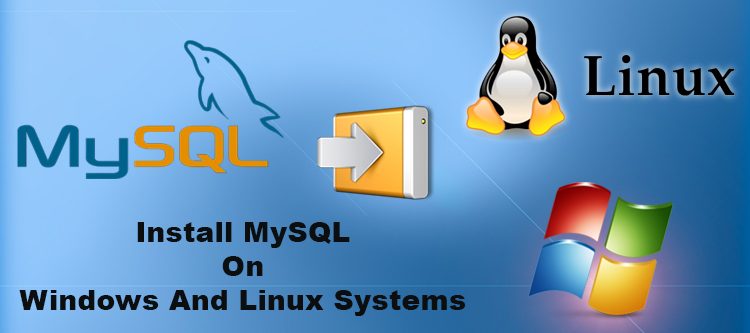MySQL is an open source relational database management system (RDBMS) that is quite popular in various business spheres. The license of this open source project is available for numerous users around the world under the GNU General Public License. It is used by a number of database users around the world due to its OS platform independent feature. This tutorial discusses how to install MySQL on Windows and Linux System.
MySQL open source database system is written in programming languages like C and C++. It can be used with a variety of operating systems like Windows, AIX, FreeBSD, Linux, OS X, OpenBSD, OpenSolaris and much more. In this blog, we are discussing the installation steps for MySQL on Microsoft Windows and Linux systems. Let us first check out the installation steps for MySQL platform on Windows systems.
Checkpoints to be cleared before the swiftly installing MySQL on Windows and Linux System
If you are one of the Windows users who is looking to install this MySQL, you need to keep in mind certain guidelines for a seamless installation process. Here are the checkpoints for Windows users during the installation process of MySQL.
Keep in mind the size of your database table- In case, the users require a table with a size more than 4GB, it is important to install MySQL platform on a NTFS or new file system. Apart from this, the user needs to use MAX_ROWS and AVG_ROW_LENGTH commands during the creation of a MySQL database table.
Resolve the anti virus scanning issue- There are certain anti virus softwares like Norton/Symantec anti virus that cause problems for directories consisting of MySQL data and temporary tables regarding the performance of MySQL platform. These anti virus softwares read the contents of MySQL files as spam and thus affects the overall performance of the database system.
To handle this situation, it is important to disable the virus scanning feature on the main directory known as datadir which is used to store the MySQL table data. The MySQL users can utilize the inbuilt feature of an anti virus softwares to avoid certain files during the virus scanning process. Apart from this, the temporary files of the MySQL platform can also be exempted from the virus scan program by configuring the separate temporary directory for MySQL temporary files and including this particular directory into the virus scanning exclusion list. For performing this critical task, you need to include a configuration option for the tmpdir parameter in the my.ini configuration file.
How to install MySQL on Windows systems?
If you are a Windows users, it is now easier to download MySQL installer for ensuring a quick installation and configuration of MySQL platform. Here are the simple steps that are involved in the installation process.
- First, download the MySQL installer from the link and run it on your Windows system.
- Now, select the appropriate Setup Type for your Windows system. Normally, it is recommended to install MySQL server and other MySQL tools associated with the MySQL development and other helpful tools such as MySQL Workbench by opting for the Developer Default setup method. Otherwise, the user needs to select the Custom setup type for the manual selection of desired MySQL products on their system.
- It is time to complete the installation process by implementing the various steps mentioned in the MySQL installation wizard. After the completion of the process, all the MySQL products are installed and MySQL server is started.
- Once, the MySQL platform is installed, it is now easier to configure MySQL to ensure the automatic initialization of MySQL server during the time of system restart.
- In this way, Windows users can flawlessly install the MySQL installer application on their system. They can use the same application later on to make any configuration or upgradation on the MySQL products.
How to install MySQL on Linux systems?
Being a platform independent database software, MySQL can be easily installed on Linux systems using Ubuntu version. If you are one of the Linux users, you need to perform the following steps for installing MySQL platform on Linux Ubuntu systems.
- Open the Linux terminal window and run the following command
sudo apt-get install mysql-server
- During the installation process, Linux users will be asked for the root password.
- To ensure the proper working and installation of the MySQL server, you need to run the following command
sudo netstat -tap | grep mysql
- Apart from this, Linux users need to check the lines as mentioned below:
tcp 0 0 localhost.localdo:mysql *:* LISTEN 13059/mysqld
- If you are experiencing problems in the working of the SQL server, it is recommended to restart it by executing the following command through Mysql.
sudo /etc/init.d/mysql restart
- Once, the MySQL is installed, Linux users can start its functioning by running the following command
mysql -u root -p
- This will change the command prompt to mysql> which will inform the users that they are currently inside the MySQL environment.
Here are the certain set of commands for Linux users in a MySQL environment:
- For creation of the database, use the following command:
create database databasename;
- For accessing the MySQL database, you need to use the following command:
use databasename;
With the help of the above Linux commands, users can now effortlessly create, insert, update and make other changes in the MySQL database without any assistance.
The above blog is a great help for both Windows and Linux users during the installation of MySQL platform. It will help these operating system users to enjoy the features and functionalities of a MySQL database in a seamless manner. If you are in need to add customized modules or new functionality on your eCommerce store based on Magento, PrestaShop or OpenCart platforms, you need to visit our Knowband store.
Liked This? You’ll Like These Too



